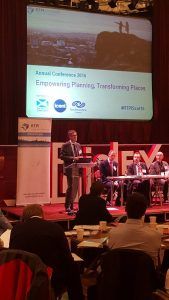On the 11th October 2016, planners representing all sectors gathered at the historic Paisley Town Hall for the 2016 RTPI Scotland Conference. In this summary article, SURF’s Jacqueline Stables presents key messages from the conference, including an update on the White Paper for Planning, proposals to transform the planning system, and case studies showcasing what planning can achieve through innovation.
► About The RTPI Scotland Conference 2016
In light of the current Planning Reform, the conference took advantage of the appetite for change to invite various speakers to present their transformative ideas on our future planning system. Presenting organisations included Renfrewshire Council, Metro Dynamics, Falkirk Council, East Renfrewshire Council, Scottish Chambers of Commerce, Scottish Federation of Housing Associations, Iceni and the Heads of Planning Scotland.

► Update on White Paper for Planning
In September 2015, an Independent Panel was asked by the Scottish Government to complete a ‘root and branch’ review of our planning system. Following a deliberative, wide-ranging consultation, the Panel provided 48 recommendations. These recommendations were welcomed by Ministers with a high level of consensus.
Consequently, the Government is aiming to produce a White Paper on Planning by December 2016. To initiate this process, six themed working groups comprising relevant stakeholders met to scrutinise the recommendations, with further discussions planned. For a summary of these working group conversations so far, follow the link here.
► Transforming the Planning System
For some of the speakers, Planning Reform offers a real opportunity to strip out the regulatory complexity and simplify the system. This section will draw out their proposals to streamline and transform the processes underpinning the Scottish Planning System.
Delivering more high quality homes
The Review calls for greater innovation in housing delivery, with emphasis on significantly increasing affordable housing. As proposed by David Stewart (SFHA), this affordable housing must be designed with inclusion and longevity in mind, in carefully considered locations. However, there are still notable barriers to delivery. Stewart highlighted that housebuilders must still make a case to gain planning permission for land already allocated for housing. As proposed in the Review and reiterated at the conference, this could be alleviated by wider implementation of Simplified Planning Zones (SPZs)1.
Additionally, delivery is also hindered by issues in acquiring land at a value that does not undermine the financial viability of development. Aligned with the Review’s recommendations, it was suggested that this could be aided by strengthening practice in Compulsory Purchase Orders (CPOs)2 and other land assembly procedures.
Although not directly addressed by the Review, Gary Mappin (Iceni) suggested that housing policy must also respond to market changes, such as the growing buy-to-let sector.
Community engagement
The need for a much stronger, committed approach to community engagement in planning was recommended emphatically by the Review. Kevin Stewart MSP expressed support for this standpoint, stressing that we must not plan at people, but collaborate with them. Notably, some of the speakers highlighted the importance of investing in digital engagement tools. In preparation for the White Paper, it was indicated that the Scottish Government will scrutinise the barriers to engagement.

Conference delegates outside Paisley Town Hall.
Funding Community Infrastructure
Section 75 contributions3 from developers can help to fund public infrastructure including roads and schools. However, as this legal mechanism can be unreliable, particularly in areas of low market demand, the Review recommends considering a national or regional infrastructure levy. Consequently, a Scottish Community Infrastructure Levy (CIL)4 is currently being modelled for the White Paper. CIL is already in operation in England, although there are mixed views on its effectiveness.
Processing Planning Applications
Echoing the Planning Review, Kevin Stewart MSP (Minister for Local Government and Housing) raised concerns over significant delays in processing planning applications, indicating that the reasons for this will be investigated.
To quicken processing times, John McNairney (Scottish Government’s Chief Planner) stated that protocols for certain planning consents will be considered for the White Paper. Another solution for faster decision-making, as suggested by the Review, is to introduce penalties for Local Authorities (LAs) when applications are not determined within the defined time limits. This is now being considered as part of a LA performance framework ahead of the White Paper.
The Review also highlighted the need for greater certainty for applicants, such as Local Authority expectations and requirements for applications. In theory, processing agreements should help to clarify these considerations. However, as they are not used widely in practice, Kevin Stewart MSP indicated that the Scottish Government plans to examine their effectiveness.
Smarter Resourcing and Culture in Planning
The significant under-resourcing of planning within Local Authorities was strongly emphasised in the Planning Review, with proposals for substantial increases in application fees to allow greater cost recovery. Support for this was voiced throughout the conference. One speaker also proposed that fees should be ring-fenced, although Steve Rodgers (HOPS) believed that Planning Departments would have to effectively demonstrate the value of this. Additionally, to make best use of existing resources, Rodgers suggested that there must be ‘smarter’ investment, such as consideration for working collaboratively.
Throughout the conference, there were suggestions that planning requires a cultural shift, from a regulatory body to one with a stronger customer focus. This is particularly important if the planning system is to act as a magnet for local and international investment.
►Transforming Places
As proposed by Kevin Stewart MSP, our planning system should add real value to people. It should actively grow and strengthen great places. Several speakers offered their view on how planners can deliver this vision – some of these approaches will now be presented.
Approaches to Town Centre Regeneration

The Russell Institute which is currently undergoing a £5 million renovation, due for completion in 2017.
Two key case studies of town centre regeneration were presented at the conference: Paisley, which has significant aspirations for the next 10 years, and also Barrhead, which has experienced significant success in boosting its prospects.
The successful Town Centre Asset Strategy, with a strong community buy-in, has initiated Paisley’s long-term culture and heritage-led regeneration programme. As explained by Alasdair Morrison (Renfrewshire Council), this will involve multi-million pound refurbishment of several key historical buildings, with the hope of catalysing further local investment. This forms a key component of the 10 year Action Plan for the Town Centre. The Plan will also address other specific matters, such as town centre living. In view of these ambitious proposals, Paisley is also currently bidding to become the UK City of Culture 2021. Supporting these long-terms changes, the Paisley First Business Improvement District (BID) continues to host a strong programme of events and activities. To stimulate property investment, the BID has also allocated shopfront improvement grants. Additionally, steps have been taken to address the number of vacant properties, through alterations to business rates.

Liberal Club on Paisley High St: Late Victorian style building for which there are aspirations to renovate and renew.
For Paisley residents, these exiting plans have ‘ignited an energy in the town’.
Gillian McCarney of East Renfrewshire Council presented the regeneration of Barrhead, SURF Award Winner 2015 for Scotland’s Most Improved Town (Small & Medium Town category). This regeneration process was shaped by the community from the outset through Charrette style workshops in 2007. Political support was also secured throughout the renewal process. These inputs informed the Urban Design Framework – an outline plan to revitalise the public realm and repair the urban fabric of the town. These enhancements focused on improving the connectivity and accessibility for pedestrians, as well as establishing and upgrading Council buildings on the Main Street. The improvements attracted significant investment within a relatively short time scale, including a new major supermarket. Additionally, the number of gap sites across the town were also regenerated for various uses including business space and a community garden, each contributing to the town’s long-term sustainability. Building on this success, there are now plans to develop further commercial space and a significant number of new houses.
Approaches to Regional Growth
As proposed by Mike Emmerich (Metro Dynamics), city regions have historically held a strong sense of place distinctiveness, built through an industrial heritage. However, location is no longer a prime consideration for employers. Emmerich proposes reinstating ‘place’ at the heart of regional strategies, with a long-term approach that is resilient against short-term policies, funding and political terms. This approach was successful in regenerating the Manchester City Region, where powers have been devolved from Westminster. This now means that the City Region Mayor can make strategic planning decisions, with consideration for the overall region. Emmerich also owes Manchester’s success to utilising place-based frameworks, as opposed to prescriptive plans. However, it was emphasised that devolution may not be the most efficient way for all city regions to address their aspirations for place. More intense negotiation and collaboration could achieve similar outcomes, without such significant administrative changes.
Approaches to Financing Infrastructure & Industry
Douglas Duff (Falkirk Council) provided a practical insight into Tax Incremental Finance (TIF) – a mechanism by which Councils can fund infrastructure investment to unlock potential for economic growth and regeneration.
Using this mechanism, Falkirk Council first identified seven strategic infrastructure projects to invest money borrowed from the Public Works Loans Board. These projects aimed to galvanise commercial interest in the area. In basic terms, TIF seeks to capture additional non-domestic rates income from developments that would not have arisen without the delivery of the infrastructure investment. This income allows the Council to repay the infrastructure to be built. In view of this, Duff was highly aware of the risk of this process to the Council’s bottom line.
Nevertheless, Falkirk’s ambitious approach has opened further options for the regeneration of the wider area such as leisure and employment uses, as well as place-making improvements.
Planning reform was a key area of interest throughout SURF’s 2016 manifesto consultations. For our final manifesto, with recommendations on long-term investment in place-based regeneration and Community Planning, follow the link here. Going forward, SURF will continue to represent our members’ interests in relevant policy development forums.
————————————–
1 Simplified Planning Zones: This is an area where the need to apply for planning permission for certain types of development is removed so long as the development complies with the details and guidance set out in the Scheme. The SPZ Scheme deals with the planning issues ‘up front’ and confirms what type of development, and how much, is allowed.
2 Compulsory Purchase Order (CPO): Usually where public authorities buy property required for projects in the public interest such as road construction, housing or town centre regeneration by reaching agreement with the owners.
3 Private sector contributions to infrastructure (S75) [also known as planning obligations]: Where community infrastructure is provided by a developer, alongside new development – the capital for this infrastructure is made available to the developer by the uplift of land value in granting planning permission.
4 Community Infrastructure Levy (CIL): A system which permits permits local authorities in England and Wales to levy a charge on new developments in their area as a contribution to local infrastructure requirements.
